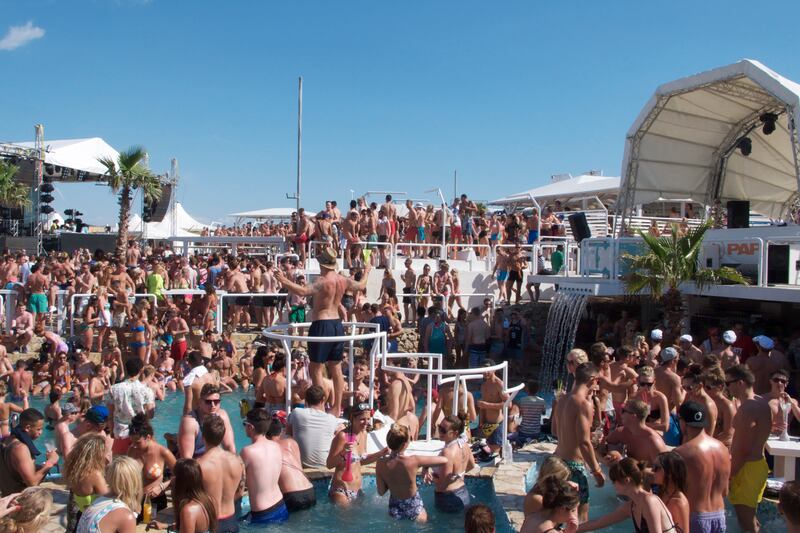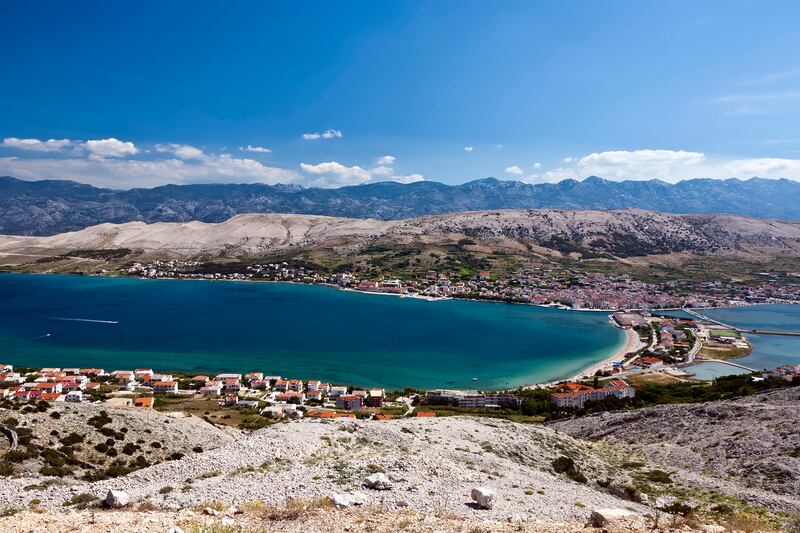Scantily-clad girls in bikinis and boys who don’t look old enough to shave pulse to the relentless electronic beat spun by rotating DJs. The nearly naked undulate and grind. To cool off, they wade through Club Papaya’s waist-deep pools. They clutch bong-shaped, jewel-toned plastic vessels containing a couple pints of various alcoholic concoctions consumed through jumbo straws. Some smoke cigarettes, some roll joints. Drugs are snorted or shot inconspicuously, but their users’ glazed and bulging eyes are a dead giveaway.

It’s 5 o’clock on a Friday afternoon in July and the after party at the Hideout Festival, a hub for electronic music lovers, is in full swing on Zrće, pronounced zer-che, the world-famous party beach on the island of Pag in Croatia. The 24-hour scene mostly congregates at Zrće’s largest club, Papaya, which hosts multiple festivals during the summer. It could be a Tuesday or a Thursday. The continuous string of revelries makes the days blur together.
For most of the year, pastoral Pag is home to roughly eight thousand residents and thirty thousand indigenous sheep. This rocky, skinny island—thirty-six miles long and about six miles at its widest point—is unique among Croatia’s islands because of its bald, moonscape appearance. It is known for its sheep’s milk cheese, Paški Sir, which has a unique flavor produced by the herbs on which the sheep graze. But the Zrće partiers don’t come to sample Pag’s cheese, admire its legendary needlework lace (Paška Čipka), visit the centuries-old Lun olive groves, or learn about the island’s once-famous salt production. Some barely leave the clubs, pausing only to catch a few hours of shut-eye in their rented rooms or to pass out on the still pristine beach.
ADVERTISEMENT
Zrće’s humble origins date back more than three decades, when the beach was simply a place to congregate with friends. “People used to go there and just chill out, and then club Calypso opened in the late eighties,” said Martina Pernar, 30, who heads marketing at the island’s largest cheese factory and has lived on Pag her entire life. “The who’s who of Croatia started coming here from Zagreb, gossip columnists started writing about it, and then fifteen years ago Papaya and Aquarius opened. After that, it just took off.”

The clubs attract people from around the world, but a large percentage of the party population comes from Germany and Italy. In recent years, Brits have bombarded the beach. The revelers’ impressions of the clubs are as different as night and day.
“It’s less like Ibiza, more like Magaluf,” said Silvia Eldawi, a 34-year-old London real-estate agent, of her first Zrće experience. “I feel old—everyone here seems to be 21, like this is their first trip away from home. I won’t be coming back.”
A group of 21-year-old ladies from London (Sofi, Holly, Vicky and Robin) had a different take. “Magaluf is shit dirty, and this is way better than Ibiza—it’s like a twenty-four-hour party. We’d definitely recommend this to anyone.”
Magaluf, a holiday resort on the Spanish island of Majorca, is best known for its notorious Magaluf strip, the nexus of its bar and club scene. Like Pag Island, Magaluf suffered some bad press due to binge drinking parties and has recently started to spruce up its image in order to attract a new type of tourist. Novalja, the northern seaside town where Zrće beach is located, is now trying to do the same.
Novalja locals are increasingly concerned by the type of tourist Zrće currently attracts. “You should go and see the promenade in the early morning,” one local (who asked not to be named) urged me. “It is filled with zombies—and their shit, piss, vomit. Some come off the buses, can’t find their way home, and collapse in the street.”
Twenty-one-year-old Michael Errington, a television salesman, rode thirty-six hours in a bus from New Castle, England just to party at Zrće. To cut costs he opted to stay in Pag town, a half-hour bus ride from the beach, instead of Novalja’s town center, only 1.2 miles away. “All the locals hate us,” he said. “They stare at us. A lot of people drink too much and fight. But I’m definitely coming back.”
The controversy over Zrće came to a head during the May 2013 elections when a close race resulted in a new Novalja mayor, Ante Dabo. The former mayor, Ivan Dabo Đono, whose reign lasted twenty consecutive years, is credited with turning the town of Novalja into what it is today—a thriving tourist economy that relies primarily on partiers to fuel its two-month-long July/August season.
“I had a vision of Novalja as a destination, an individual community not associated with Pag town,” former mayor Ivan Dabo Đono said. “We had the idea of the development of good clubs, a ‘Croatian Ibiza’ brand. It just happened faster than I expected.”
Locals may dislike Zrće and the tourists it attracts, but no one can argue that it is a massive revenue generator for the island; many have profited from its existence, from restaurants to taxi drivers to families who rent private rooms. According to the former mayor, Novalja attracts three hundred times more tourists today than seven years ago. At peak season, the town reaches its 20,000-person capacity.
Prior to the Zrće tourism boom, Pag residents described Novalja as a “small village” envious of Pag Town to the south. A profitable salt trade and influx of wealthy merchants and nobility during medieval times had made Pag Town the centerpiece of the island. Even in this century, tourism there flourished, in part due to its proximity to Zadar, a historic city on Croatia’s Dalmatian coast. But today, the tables have turned: Novalja grew 11 percent in the past decade, swelling to 4,500 people—more than half of the island’s population—which speaks to the strength of the economy, in large part due to the globally-recognized Zrće brand.
The new mayor-elect is tasked with a tricky balancing act: how to maintain and contain the Zrće party tourism while striving to attract different kinds of tourists who will take advantage of Pag’s cultural and gastronomic offerings.
“In the next ten years, we would like to see three types of tourist development: rural, five-star and Zrće,” mayor Ante Dabo said. “If we make sure to have order in Novalja, they can coexist. Zrće will remain a party zone, but the town will not.”
Croatia, the 28th member of the European Union as of July 1st, 2013, is striving to integrate into its new European community. Dabo says he is eliminating the “grey zones” that previously fostered corruption, and with the cooperation of the clubs, is helping to clean up Novalja and make Zrće a safer place for visitors. He hopes Novalja will benefit from the 1.5 million euros the EU has allocated for regional development in Croatia, and would love to create a new brand of ethno-tourism, in addition to encouraging the development of the first five-star hotels on the island.
“A dominant type of tourism is dangerous,” Ante Dabo said. “Zrće has chased away many other tourists, and we want them back.”
But Zrće shows no signs of slowing down—if anything, it is gaining momentum as word spreads around the globe. If the trend continues, Novalja will likely need to build new, affordable accommodations for partiers, in addition to the rural and five-star projects for the future tourists it hopes to attract.
“Zrće is too strong to stop,” former mayor Ivan Dabo Đono said, smiling.






